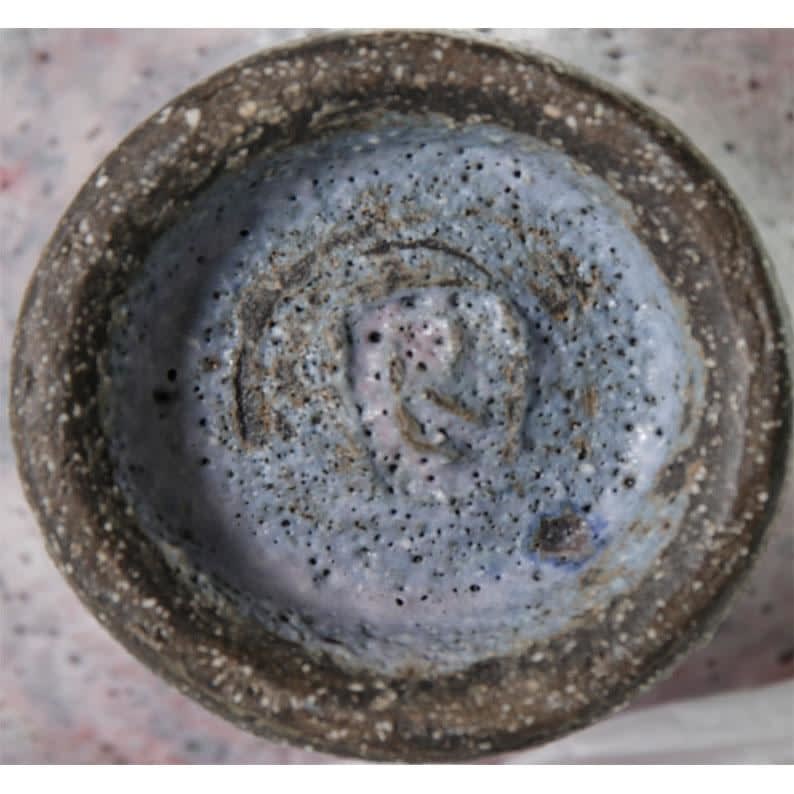Lucie Rie (1902–1995)
Vase with Spiral Pattern
Stoneware
Marked "LR" on foot
Double boxed
W12.4 x H24 cm
Marked "LR" on foot
Double boxed
W12.4 x H24 cm
Further images
This slender vase comes with a flared rim, bulging body and a high foot; subtle color changes occur as the light pink gives way to greenish blue and white tones that spiral up the entire wall. Bubbles spread all over the body, creating a rough texture.
This spiral pattern is regarded typical of Lucie Rie’s work. Rie experimented first with the method in the latter half of the 1960s. She would join two or more lumps of differently colored clay and then throw the piece on the potter’s wheel. The centrifugal forces, resulting from acceleration carefully controlled by the artist, would create a unique, soft diffusion of contrasting colors.
Rie left behind a huge amount of the notes regarding the methods and techniques of glazing, proving that the artist was extremely keen on experimenting with a wide spectrum of colors and glazes. This dry, pitted “volcanic” texture in the present work resulted from brushing the glaze on the body before firing, rather than the dipping, pouring or spraying methods that were frequently used in pottery making. This procedure retained the small bubbles of air as the glaze was applied. Many of the bubbles survived the firing, leaving a mass of tiny pits in the glazed surface.
In Lucie Rie’s life, there were two people who inspired her in her artistic career: one was Bernard Leach and the other Hans Coper. Bernard Leach’s view on extolling yonobi, namely beauty of utility, was in opposition to the decorative design that Rie learned in Vienna in her early time, when she still struggled to find her own artistic voice. Nevertheless, Leach’s suggestion of acquiring knowledge of the Eastern ceramics led her to explore new possibilities in pottery making. For instance, the refined shapes of Cizhou ware of Liao dynasty of China might have served as an inspiration for the present vase. Moreover, Hans Coper’s concept of abstract and sculptural forms encouraged Rie to embrace a more sophisticated, urbane manner of creating works. The present vase is a good example to exemplify Rie’s dual interest in Chinese ceramics and modernism. It reveals her unique aesthetics regarding choices of color and glaze.
Lucie Rie (potter; 1902–1995)
Born in Vienna, Rie studied ceramics under Michael Powolny at the School of Arts and Crafts in Vienna. After the German takeover of Austria, she emigrated to London in 1938, where she established a pottery studio near Hyde Park. Her early work shows the influence of Jugendstil, Neoclassicism and Japonism. Rie maintained a friendship with Bernard Leach, though in contrast to Leach her style relied on brightly colored, modernist aesthetics. She was awarded the title Dame Commander of the Order of the British Empire in 1991.
This spiral pattern is regarded typical of Lucie Rie’s work. Rie experimented first with the method in the latter half of the 1960s. She would join two or more lumps of differently colored clay and then throw the piece on the potter’s wheel. The centrifugal forces, resulting from acceleration carefully controlled by the artist, would create a unique, soft diffusion of contrasting colors.
Rie left behind a huge amount of the notes regarding the methods and techniques of glazing, proving that the artist was extremely keen on experimenting with a wide spectrum of colors and glazes. This dry, pitted “volcanic” texture in the present work resulted from brushing the glaze on the body before firing, rather than the dipping, pouring or spraying methods that were frequently used in pottery making. This procedure retained the small bubbles of air as the glaze was applied. Many of the bubbles survived the firing, leaving a mass of tiny pits in the glazed surface.
In Lucie Rie’s life, there were two people who inspired her in her artistic career: one was Bernard Leach and the other Hans Coper. Bernard Leach’s view on extolling yonobi, namely beauty of utility, was in opposition to the decorative design that Rie learned in Vienna in her early time, when she still struggled to find her own artistic voice. Nevertheless, Leach’s suggestion of acquiring knowledge of the Eastern ceramics led her to explore new possibilities in pottery making. For instance, the refined shapes of Cizhou ware of Liao dynasty of China might have served as an inspiration for the present vase. Moreover, Hans Coper’s concept of abstract and sculptural forms encouraged Rie to embrace a more sophisticated, urbane manner of creating works. The present vase is a good example to exemplify Rie’s dual interest in Chinese ceramics and modernism. It reveals her unique aesthetics regarding choices of color and glaze.
Lucie Rie (potter; 1902–1995)
Born in Vienna, Rie studied ceramics under Michael Powolny at the School of Arts and Crafts in Vienna. After the German takeover of Austria, she emigrated to London in 1938, where she established a pottery studio near Hyde Park. Her early work shows the influence of Jugendstil, Neoclassicism and Japonism. Rie maintained a friendship with Bernard Leach, though in contrast to Leach her style relied on brightly colored, modernist aesthetics. She was awarded the title Dame Commander of the Order of the British Empire in 1991.







